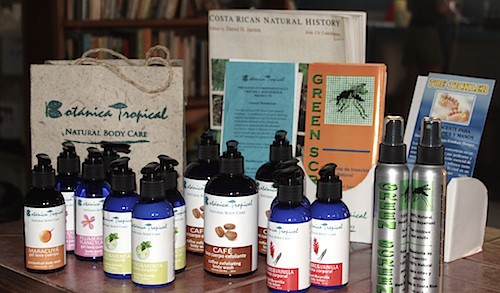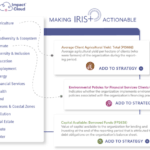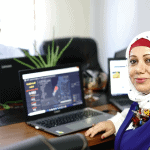The Accidental Social Entrepreneur: A Hippie Ecologist’s Foray into a Costa Rican Business Start-up
The allure of the tropics captured me while doing research in Nicaragua during grad school, so days after getting my committee’s signatures on my dissertation, I hopped on a plane to Costa Rica. I took a job at the Center for Sustainable Development Studies teaching ecology in a field-based, experiential education semester abroad program. However, after six-plus years, I needed a break from living at my job (faculty were required to reside on site). But I wasn’t ready to leave Costa Rica … What to do next?
Pondering that question brought up the concepts of sustainability we had been teaching, the ethnobotany and organic market research projects carried out with students, and my own experiences in the field. They came together in my head and I had the answer: Start a business making natural insect repellent using locally grown ingredients. Thus Green Screen was born and I became a environmental/social entrepreneur – although at the time, I didn’t know it.
I had an idea, but not a plan. Developing the formula was easy; I had the scientific background to blend traditional knowledge with academic and industry practice. It was apparent to me that in order to develop sustainably, Costa Ricans needed to move away from their economic model of exporting raw agricultural goods and focus on using their natural resources in a way that allowed regeneration and renewal at a rate equal to or greater than depletion. I selected fast-growing, herbaceous plants for the formula to minimize regrowth time, and had plans drawn up for an essential oil distillation facility to be run on biogas (which would be generated from cattle manure gathered from a friend’s dairy farm). Market-wise, I concentrated on the national one, keeping costs and margins at a level to make the final price accessible to local consumers, even though the advice I got mostly suggested going after the larger, more affluent international market.
A friend in the non-profit world who worked with rural campesino groups (which organize farmers) introduced me to some farmers up around the northern slopes of Rincon de la Vieja and told me about a few plants they used as a mosquito repellent. I developed a rapport with one family, and they agreed to harvest and sell me a species included in the final formula which grew abundantly in an unused piece of land next to their farm. I came to know other families in the area through bringing in annual school supply donations collected from tourists and expats, so when tourist rental cabins were built on that vacant land, other farmers filled the demand. As sales grew and more development happened around the area (electricity came to the region around 2008) we made plans to encourage the regeneration of the individual plants that grew spontaneously on their farms, as well as collect and plant seeds from the ones found along the roadside.
Finding appropriate packaging and designing the label and logo was actually fun. Legal formation of the company, trademark registration and tax compliance I contracted out to a lawyer and an accountant. Navigating the Ministry of Health product registration process required some patience, determination and an obsessive attention to detail. At the time, nothing was digital and submitting a paper application with the page numbers in the wrong corner was grounds for rejection (although the license fees and costs for required tests were quite accessible). But the substantial challenges came in sales and marketing.
When I launched Green Screen in 2002, no other plant-based insect repellents were on the market in Costa Rica, only one brand of natural body care products was widely available and certification requirements for organic products had just recently been legislated. Distributors and retailers didn’t really have “natural products” on their radar and sometimes even regarded them with suspicion. I called repeatedly and insisted that a company, which held concessions on several major hotel gift shops, allow me 10 minutes to present my product. When I finally got it to the purchasing manager, he told me he was expecting a foul smelling brown sludge and was pleasantly surprised with the product presentation.
Other retailers had other biases. A major supermarket chain told me they liked the product and thought the price very reasonable but they wouldn’t deal with me because I was too “small.” They only dealt with large scale distributors supplying multiple products and suggested I find such a middle man. Some stores “sold” shelf space and wanted payment to place product where it was easily visible. Another distributor informed me that nothing moved without “push money,” a small commission we would jointly pay to the salespeople in shops for every bottle they sold. I had no clue about these marketing tactics, nor any budget allocation for them or other types of promotion. I took out a few ads, got some good press from sympathetic journalists in tourist-targeted publications and relied on word of mouth.
Gradually sales increased, albeit probably not as much as they would have with a marketing strategy and budget, and I expanded the line to include body care and spa products. Then the middle men started contacting me, with slight variations of the same plan: They wanted 1) exclusivity in representation (which I insisted had to be earned based on product volume sales); 2) me to provide all the free samples they would give away (this was somewhat negotiable); 3) me to extend credit on all sales they made; and 4) to be able to collect payment on the sales and take their commissions out. This accounted for zero risk or upfront monetary investment on their part, not exactly a partnership to say the least.
Although Costa Rica is only about the size of West Virginia in actual area, the variations in terrain and the patchwork of undeveloped protected areas which make it famous for its rich biodiversity present some difficulties in transporting goods throughout the country. This was exacerbated by a highly San Jose-centric business and development culture, with the ruling class protecting their economic interests there, even as the government was expanding access to services via regional offices around the country. Since I manufactured everything in the rural North Pacific region, getting product to any other part of the country involved shipping to San Jose first, where most often the goods had to be taken to another local transport company to be sent to their final destination.

An array of Green Screen products. (Image: Lisa Bradshaw.)
Over time I worked through the logistics and even got some incentives from government programs designed to help develop and promote small businesses. Things were stable, but I was still essentially doing it all by myself and this led to feelings of isolation – something every entrepreneur feels at one time or another. On top of that, events in my personal life all pointed to returning to the U.S. It was time to sell the business, another venture I had no idea how to approach. Fortunately, a lifelong friend of mine has her MBA from the University of Michigan and coached me through the process. After two offers fell through, the sale finally closed on the third offer, which came from one of my clients. So, the convergence of ideas I had 16 years ago is a thriving business, infused with new energy in Costa Rica and I’m back in the U.S., ready for the next chapter in life.
But I learned many lessons throughout my 15-year stint as an entrepreneur: practical, personal and professional ones, and sometimes about things I had no previous interest in knowing. Often times I learned these things reluctantly, but I don’t regret any of it. However, if I had a “do over” or were to offer any advice to others considering the entrepreneurial route, it would be to heed the obvious:
1) Don’t fly by the seat of your pants. Great ideas can arise spontaneously, but when you have one, create a detailed plan with contingencies to execute it.
2) Don’t fly solo.
Every individual has their strengths and weaknesses, so having partners with complementary skills strengthens the business overall. Furthermore, pooled resources and energy spreads enthusiasm and inspiration while decreasing isolation and risk. In short, team work makes the dream work.
Above photo: A misty view from Rincon de la Vieja in Costa Rica. Flickr credit: Patrick Nouhailler.
Lisa Bradshaw is a lecturer at the University of Michigan Dearborn and is employed in Undergraduate Admissions at U-M’s Ross School of Business.
- Categories
- Agriculture, Environment, Social Enterprise



